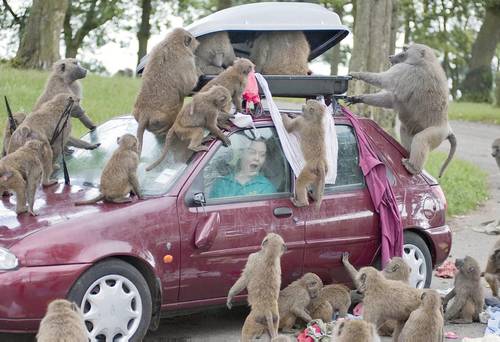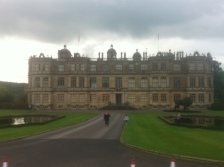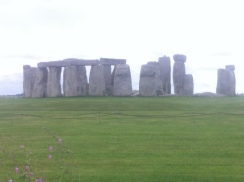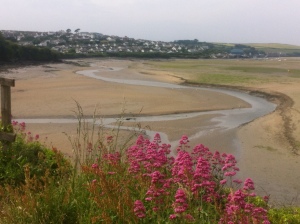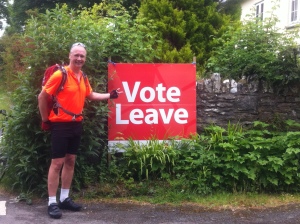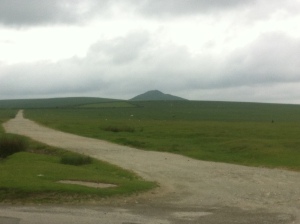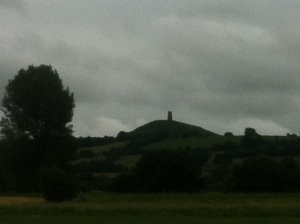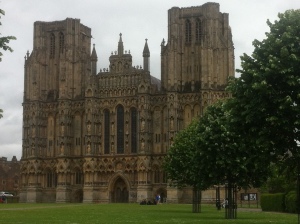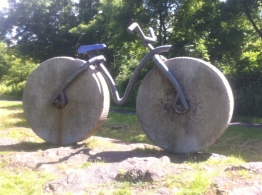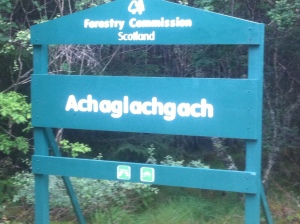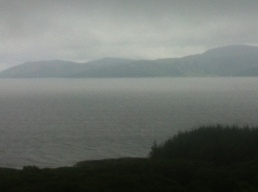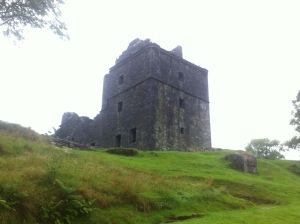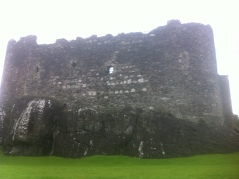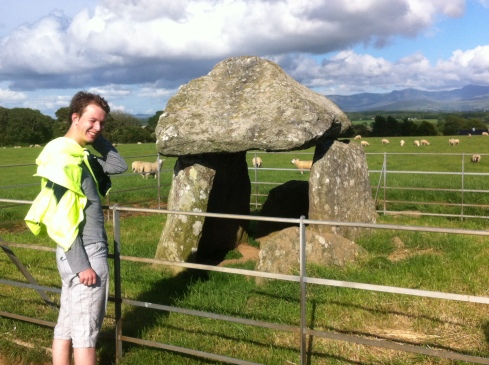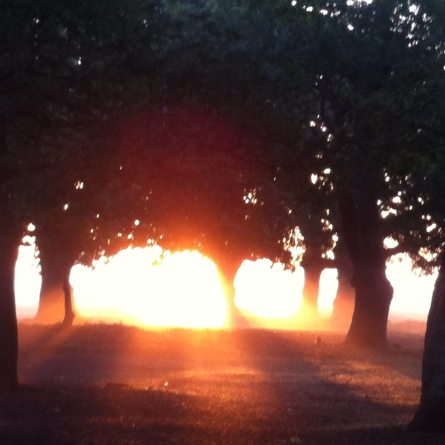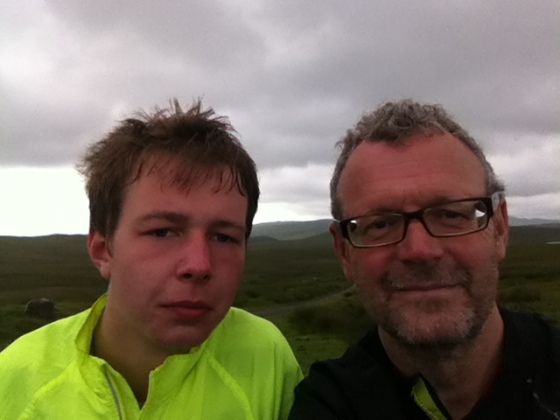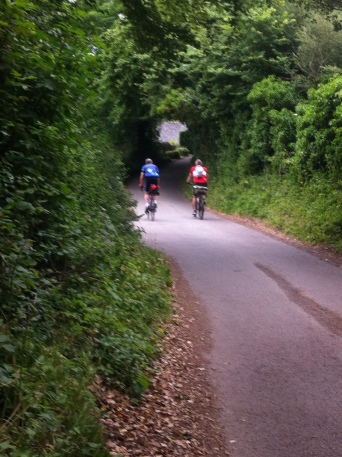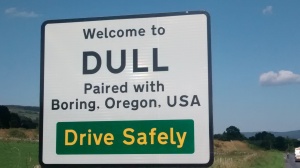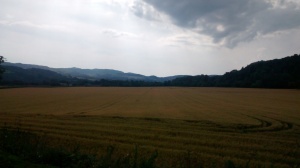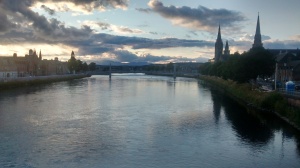Over a long weekend in September 2017 my friends Jeff, Matt, Tim and I tackled our first proper mountain bike adventure: the iconic South Downs Way, a 100-mile off-road track from Winchester to Eastbourne.
I like to think of this trip as character-building. Following a period of rain the chalk surface had become slippery and treacherous in many places. Further heavy showers during the weekend added to our difficulties. We found ourselves bogged down in fields of cow shit. Cycling uphill, through a forest, the path ahead of us turned into a cascading torrent of water. We suffered a record number of punctures, embarrassingly most of them mine. Nobody else appeared to be cycling the South Downs Way that weekend, though there were plenty of walkers. We were regularly overtaken by people trudging past us in cagoules carrying heavy rucksacks, looking like they might be having a slightly less miserable time than we were. We got so lost on the first day that the owner of the B&B where we were meant to be staying was driving round Sussex in a van trying to find us. Even a night spent kicking a snoring room-mate in the head, or the sight of Tim half way up a hill, kicking and hurling abuse at his bicycle – as diverting as these small pleasures were – could not make up for the disappointments of this trip. We finally bailed out at Monday lunchtime, having completed less than half of the route.
So it was that in June 2018 we decided to head much further south in search of sunnier climes. We settled on the Pirinexus, a 220-mile circular route around Catalonia and southern France…
The night before the trip we pick up our hire bikes – four brand new mountain bikes gleaming a cheerful bright yellow. We have only brought one spare inner tube between us but the man in the shop refuses point blank to sell us any more. The bikes, he tells us, are fitted with ‘self-mending’ tubes. At the merest suspicion of a puncture they will automatically squirt an adhesive green goo around the rim of the tyre, immediately sealing up the hole.
‘Puncture!’ he says, laughing dismissively, as if it is a thing of the past, a quaint relic of cycling history that went out with penny farthings and bicycle clips and old ladies riding to church.
‘Hey, Carlos’, he calls to his young assistant. ‘These guys worry about puncture!’
Carlos chuckles and the man gives him a clip around the ear for no apparent reason. I have an uneasy feeling about all this but I don’t like to say anything.
Early next morning we begin the ride with a group selfie by the statue of the 1990 Barcelona Olympic torch on Escala beach front, before following the road down the coast in search of a suitable place to stop for breakfast. Ahead of us a lemon and green striped hot air balloon hovers listlessly in the morning air, tethered to a tree and awaiting its first passengers of the day.
In the pretty town of Toroella de Montgri we stop for omelette bocadillos and coffee in the main square, surrounded by tall elegant buildings, one of them bearing a faded blue sun dial dated 1725. The town hall is draped in yellow ribbons, the symbol of the campaign to free the pro-Catalonian independence politicians who have recently been imprisoned by the Spanish state for acts of rebellion and sedition. Everywhere we go over the next few days we will see these ribbons, wrapped around lampposts and trees, painted on the sides of buildings and on the surface of roads, festooned throughout villages, town centres, and even in remote forests high up in the mountains.
We set off again, passing fields of tall yellow sunflowers serenading us in the breeze. Later in the morning we turn off the tarmacked cycle lane onto a sandy, boulder-strewn path running through woods. The path careers bumpily downhill towards the blue sea twinkling through a gap in the trees. Dumping the bikes on the beach we hurtle into the sea in our cycle shorts. The first swim of the summer. We haven’t bothered to bring towels but it takes just minutes to dry off in the noonday sun, perched like lizards on a rock jutting out from the cliff at the edge of the beach.
We re-join the road and cycle on to a seafront restaurant in the town of San Antoni de Calonge on the Costa Brava. The first lunch of our trip is a gloopy stew of rice, blackened with squid ink and mixed with mussels, prawns and dark savoury mushrooms, with crusty bread to mop up the rich juices. Swilled down with a carafe of crisp, light rosado – the first of a great many over the coming days – it sets the culinary bar high for the rest of the tour.
Heading inland after lunch we follow the tracks of the old narrow-gauge railway path running from Sant Feliu de Guíxols all the way to Girona. The path skirts the edge of Llagostera, its medieval town centre perched high on a hilltop crowned by a picture book castle. The late afternoon sky clouds over and yellows ominously, darkening in patches like a bruised peach. There are distant rumbles and the air thickens with a sense of impending downpour. The track zig-zags its way across fields which are kept vividly green by water sprinklers towering overhead. We ride through, trying and failing to dodge the rotating water-jets. We end up getting thoroughly soaked and it hasn’t even started to rain yet. Then it begins to fall steadily for the last hour of the journey (how often does this seem to happen at the very end of a cycling day?) But this is warm, gentle rain which seems to evaporate in the heat almost as soon as it touches the skin.
Reaching Girona we find our accommodation for the night, a tenth floor apartment in a tower block in the city centre. There is nowhere to leave the bikes securely at the ground level. We spend an amusing half hour struggling one at a time up ten floors with our, by now, rather filthy machines, in an ancient wheezing lift which seems to stop at every floor, constantly apologising and making way for other residents to squeeze in. When we finally get inside the very plush apartment, leaving the muddy bikes in the hall, the views from the kitchen window are spectacular and vertigo-inducing. Far below a tangle of mainline railway lines pours away from Girona station, converging on some unknown vanishing point in the far distance.
The first coin toss of the trip takes place to decide on rooms. I win the top prize – the Penthouse extension with king-size bed and en suite bathroom all to myself. I immediately appoint Jeff as my personal butler. He makes a decent start by offering to wash my fetid shorts, shirt and socks in the automatic washing machine provided.
This is a World Cup trip – the first since 2014 when we spent several days cycling around rural France desperately trying to find a bar with a TV that stayed open after 7 o’clock in the evening. There’s no shortage of places to watch the football here. But it’s an inauspicious start, watching England reserves lose 1-0 to Belgium reserves in a tepid game in a bar in the main square (both sides having already qualified for the knock-out stage). Later we cross into Girona old town for pizzas and afterwards sit smoking on the steps of the cathedral, the coldness of the ancient stones a welcome relief in the warm, sticky night air.
Next morning we pick up the Pirinexus route rolling out through parkland to the west of Girona, weaving through a chain of market gardens full of sun-dappled greenery and bursting with ripe apples, peaches and melons. The route re-joins the old railway track, climbing steadily all the way up to the town of Olot some 40 miles north. Purple mountains loom ahead in the distance, the scree on their high slopes gleaming white in the mid-morning sun.
This morning’s ride flows through a number of river valleys, the Ter, Fluvia and Carrilet. There are tantalising glimpses of these rivers through the trees, looking green and enticing in the rising heat of the day. Even when they are hidden from sight there is the constant sound of water, rushing over weirs and water falls, gurgling and plopping amiably in the tranquil sections in between. Just beyond the village of Les Planes d’Hostoles begins a series of picturesque gorges. A natural bathing pool has formed at the first of these. Abandoning our bikes at the top, we run down the rocky steps and plunge heroically (me)/tread gingerly (them)into the clear, cold water. The pool is soft and spongy underfoot at the edges and unfathomably deep in the middle. The midday sun pulses through the tall trees that circle the water. This is the kind of enchanted place a weary traveller might stumble upon in legend, seeing a vision of beautiful wood nymphs sunning on the rocks. But if there are any weary travellers around today, they will have to make do with a vision of 50-something blokes in unfeasibly tight-fitting leisurewear, hauling themselves out of the water and trying to get their pants dry before lunch.
There’s nothing like a spot of wild swimming to work up an appetite. Back in the village we find a restaurant on the main road. It’s a bit shabby-looking with long plastic tables and chairs, but full of locals taking advantage of the ridiculously good value eleven euro menu del dia. For our eleven euros we enjoy salad/soup, anchovies/meatballs, the ubiquitous Crème Catalan and the inevitable litre of rosado. An hour later we exit quickly leaving a small tip and an embarrassing damp patch on the seats.
We continue towards Olot at a sleepy mid-afternoon pace along the old railway track, stopping at one of the disused old stations for a brief power-siesta in a shady pine-scented nook. Olot is a nondescript place notable for its abattoir and old men slumped boozily on park benches. We refuel on fizzy drinks and chocolate in preparation for the hellish hill which starts almost as soon as we leave the town. It’s an unforgiving 10 kilometre climb, leg and soul-sapping. The late afternoon cloud cover offers some protection from the scorching rays but the air is thick and sticky. The road winds up the mountain-side punctuated by a series of hair-pin turns. All the while up I am concentrating on the two feet of tarmac just in front, trying not to look any further ahead. It’s morale-crushing when you see the road stretching upwards as far as the eye can see then twisting around the next bend. I occasionally glance to my left to take in the dramatic valley below and the steep mountains on the far side, covered with dense green forests. The silence of the afternoon is broken only by my ragged breathing and the faint tinkling of cow-bells down in the valley.
As usual Jeff, followed by Matt, is the first to reach the summit. When I finally look up and see them waiting at the side of the road my joy is unbound. The hill is followed by a plunge of several kilometres back down into the valley to the village of Sant Joan de les Abadesses. The descent is deeply pleasurable, combining the liberation of freewheeling at adrenaline-pumping high speed with the concentration and skill needed for braking and banking around the tight hairpins. As the wind rises I remove my trilby hat and stuff it into my pannier. The evening sun bleeds through the clouds and the countryside rushes past in a green and gold blur, the cool breeze blowing into our faces and whipping up our hair.
From the bottom it’s still another ten miles to our night stop, though luckily there are no football kick-offs to make as today is a rest day in the World Cup. Tim, exhausted from the long climb up from Olot, appears close to mutiny and can only be cajoled into pressing on with the promise of the world’s largest Negroni up ahead. As the last light of the day begins to drain away we arrive at the village of Camprodon nestling in the foothills of the mountains, its narrow cobbled streets and arched 13th century bridge straddling the rushing waters of the Ter.
We check into the Hostel La Placeta just in time to shower and eat before the restaurant closes. The owner of the hotel hovers in the background. His manner is courteous but distracted. His furrowed brow, far-away manner and furtive phone calls hint, we surmise, at a possibly troubled personal life or shady drugs deal. We dine handsomely on cream of courgette soup, a plate of toasted tomato bread and local Pyrenean cheeses, chocolate mousse, a flagon of vina rosado and a cheeky Spanish grappa and coffee, before the obligatory smoke in the village square before bed.
Feeling a tad guilty about last night’s penthouse suite I’ve offered to take one for the team tonight, volunteering to share with X. We are billeted in room 101. This is entirely appropriate since it is about to contain what is beyond doubt the worst thing in the world. X’s snoring. Luckily my preparations for a good night’s sleep have been assiduous: 100 kilometres of cycling (including a height gain the equivalent of Ben Nevis), a bout of wild swimming, two three-course meals, a river of rosado, and Boot’s premium brand of ear plugs. While I cannot claim total success for this strategy it does at least file some of the rougher edges off the noise. As I bob in and out of bleary consciousness during the night I even fancy I hear the purring of a contented, if somewhat bronchial, pussycat in the adjoining bed. I’m not going to lie. It’s not the best night’s sleep I’ve ever had. But it’s definitely the best night’s sleep I’ve ever had in a room containing X.
We descend next morning to a splendid buffet piled high with cheeses, cold meats, freshly baked breads, pastries and fruit. El patron bids us a grumpy ‘bon dia’, then skulks in the background giving off more negative vibes. His brow appears to have become even more tightly knitted during the night. After serving us coffee he fields another series of hushed phone calls. He does not have the air of a man at peace with his world.
Today’s ride of forty miles is mercifully much shorter than the last two days, but involves crossing the Pyrenees into France. We also need to reach our night stop Ceret in time to watch the tasty looking France v Argentina knock-out game in front of a partisan crowd at 4pm. And it goes without saying that we have to fit in a long, boozy lunch somewhere along the way as well. I sometimes wonder if loved ones back home understand the kind of pressure we are under on these trips.
The climb over the mountains, around 7 kilometres in length, is a little shorter than yesterday’s. But it has a sharper incline and has to be tackled in the full glare of the mid-morning sun, save for the occasional patch of tree-shaded respite. All the way up we are strafed by a swarm of black-clad motor cyclists screaming past us up and down the hill.
I’m not normally that quick going uphill but I seem to be inexplicably on fire this morning. I settle early into a comfortable gear and a regular rhythm on the pedals that I know I can sustain for the 45 minutes or so it will take to get to the top. Half way up I look up to see Jeff only 20 metres ahead. Astonishingly I appear to be reeling him in for the first time ever! He glances back quickly, probably expecting to see Matt, then does a sharp double-take, his eyes popping out on stalks like a cartoon cat. Then he’s immediately up and bobbing around in the saddle, striving to reassert his authority. I grin, knowing I’ll never catch him, but treasuring the moment.
We rest at the summit, drinking in the stupendous views of the emerald green valleys and tiny Monopoly board houses far below, on one side back down into Spain, on the other over into France. The air feels so much sharper this high up. We take a group selfie by the border sign. An information board describes the flight of Republicans pursued by Franco’s henchmen over this pass some eighty years ago. The descent into France is another extraordinary freewheel whoosh for several miles, hurtling down the straights, breaking hard as we slalom around the bends.
It’s approaching lunchtime but we’re pressed for time if we are to make the afternoon kick-off in Ceret. The last thing we want is a last minute rush in the heat of the day. We consider breaking with tradition for once and stopping for only a quick cheese baguette on the hoof. Half an hour later we are in a shady courtyard being served warm goat’s cheese salad, salmon in Provencal sauce with pommes dauphinoise , roasted peppers and courgettes, melon, un grand carafe de rose and coffee. Followed by a mad ten mile dash into Ceret.
We arrive in the main square just after kick-off. A large crowd is gathered around tables outside a brasserie watching the game on a big screen. On the edge of the square a fat man smoking a pipe, his foot in plaster, beckons us to sit down. By his side he has a large, lumpy sack and a shotgun. Something brown and felt-like is sticking out of the top of the sack. A young waiter, bobbing in and out of the brasserie at a frenetic pace, brings us a tray of ice cold beers. At the table in front of us two young couples sit drinking and smoking. During the course of the match a succession of other friends arrive, in ones and twos, giving rise to ever more complex and time-consuming permutations of cheek-kissing.
The game is electrifying, perhaps the game of the World Cup. France take an early lead then Argentina hit back with goals either side of half time. France score three times in a glorious 11-minute burst orchestrated by boy-wizard Mbappe, before Argentina pull one back to lose 4-3. The wind, as if in tandem with the drama on the pitch, whips up violently, typical of southern France/northern Spain with its Mistrals and Tramonteras and their unruly local cousins. High above our heads, the branches of the tall trees in the square sway alarmingly, shaking out leaves and twigs into our beer, the wind carrying the fresh scent of pine resin.
The mood of the crowd ebbs and flows as the narrative of the game unfolds. We arrive as neutrals but the tide is irresistible and by the second half we’re cheering every French move. The young waiter scurries back and forth, weaving through the packed tables, carrying a tray wobbling with drinks balanced on one hand like a trapeze artist. His appearance turns increasingly triumphalist, emerging from the bar draped in the Tricolore, later sporting a flamboyant D’Artagnan hat with a crimson feather. At the final whistle I half expect him to appear on a white charger, swinging a sword and singing the Marseillaise.
But for all the joie de vie and relaxed bonhomie on display, celebrations at the final whistle are strangely muted as everyone packs up immediately and goes home. It’s not that they weren’t up for the game or aren’t pleased by the result. But somehow it doesn’t seem to matter quite as much as it would to the English. It’s probably a far healthier response. Some even leave ten minutes before the end when France are 4-2 up, including our neighbour with the gammy foot and the sack of dead bunnies. He hobbles across the road, takes out a large bunch of keys and opens the door to a shop called La Chasse et la Peche (Hunting and Fishing).
Tonight’s digs are the Hotel Vidal, pretty basic with twin rooms so cramped you could barely swing ‘un chat’ in them. On the plus side the rooms are wonderfully positioned around an old courtyard covered in vines heavy with fruit. We wash out our cycling gear before I manage to come up with a new entry for my forthcoming best-seller 1,001 things to do with a bungee before you die. Number 794 (spoiler alert) is ‘constructing a makeshift washing line’ between the curtain rail and a drainpipe outside the window. We later return to the brasserie in the square for goat’s cheese salads, more beers and another entertaining last sixteen game between Uruguay and Portugal.
The next morning the owner of the Hotel Vidal offers a cheery contrast with our host at the Hostel La Placeta in Camprodon, indulging in some light-hearted banter about our cycling exploits and England’s chances in the football. We accept his offer of petit dejeuner at ten euros a head. Unfortunately there seems to be a rule in the Pyrenean hospitality industry that the quality of the breakfast is in inverse proportion to the mental health of the proprietor. We are served a thin spread of stale pastries and little catering pots of jam, with not a crumb of fresh bread in sight. It’s a paltry affair redeemed only by being served in the loveliest of locations in the leafy courtyard. Later, cycling out of Ceret, we pass the hotel owner strolling along the main street carrying a bag stuffed with newly-baked baguettes and flaky croissants. He is whistling a jaunty tune and has the air of a man who has just made an easy forty euros and is looking forward to reading the Sunday papers and stuffing his face.
The heat is more intense today and before long we have worked up a sweat. We stop for refreshments in the French border village of Le Boulou, ordering drinks at a pavement café. The owner refuses to sell Matt a coke. She then delivers a long diatribe against the evils of sugary drinks, causing Matt to decamp in a huff to another café further down the street where they are more than happy to meet his glucose requirements. Meanwhile, she offers us some useful tips on avoiding dehydration (she suggests a regular intake of water), along with how to avoid sunstroke (she recommends the use of suntan lotion as a protective barrier). While sharing this sage advice she draws deeply on an untipped Gitanes.
Soon after Le Boulou we begin climbing to the summit of the Coll de Panissars, the scene of a famous 13th century battle between the French King Phillip III and Peter III of Aragon. The descent back down into Spain is off-road. The earth is parched and rocky, with the occasional green flash of a darting lizard. The air is filled with yellow butterflies and the scent of sun-baked rosemary. This is proper mountain biking, an exhilarating and hair-raising scramble where we just have to cling on and hope for the best much of the time. Reaching the bottom of the hill we pass a man out walking, wearing no clothes apart from a very tiny, very tight pair of Speedos. He is carrying an enormous loofah, although oddly there do not seem to be any suitable places for bathing anywhere for miles around.
After the final lunch of the trip in the Spanish border town of Jonquera we think about finding somewhere to watch the afternoon knock-out game between Spain and Russia. Watching France win their last 16 match in Ceret has been a highlight of the trip. Watching Spain do the same now we are back on Spanish turf promises to be just as memorable. But finding a place to watch the game proves challenging as we find ourselves stuck in an expanse of arid countryside with few signs of civilisation. Taking a long detour from the main route we wind up in the small village of Cabanes. Its hot, dusty streets and atmosphere of permanent siesta make it feel like the sleepy town in a spaghetti western just before the gunfight starts. You expect a cigar-chewing man in a poncho to turn up on a mule and growl ‘Get three coffins ready.’ The Cabanes Social Club in the village square appears to be the hub of what passes for action around here. A TV in the corner is showing the game, but there are just a couple of blokes at the bar – one of whom is wearing a red and white chequered Croatia shirt – and a mangy dog. It would appear that the national side has not really fired the imagination of Catalonians, perhaps understandable in the current political context.
Spain are already one up after an early own goal when we arrive and look to be cruising towards an easy passage into the quarter finals. But a penalty on the cusp of half-time lifts the hopes of the Russians, who then hang on with grim determination for the entire second half and extra time to win the penalty shoot-out. The frustrated Spanish team have total, but meaningless, possession, endlessly passing the ball around in complex geometric patterns that never threaten to breach the resolute Russian defence. The Spanish commentator prattles incessantly and maintains a state of high excitement, even though there is not the remotest chance of anything ever happening. He recites the names after each pointless pass in a crescendo of rising anticipation, an endless mantra of ‘Ramosss…Picquaay…Iniestaaa…JORDI ALBAAAA!’, followed by yet another pass back to the goalkeeper. Spain pass the ball 1,107 times during one of the most tedious matches ever played, a game so stultifying it makes you question why you bother to watch football at all. Let alone on a glorious June afternoon in northern Spain when you might have got to the beach by now, plunging into the beautiful blue waters of the Costa Brava.
The boredom of the game combines with the intense afternoon heat to produce a strange hypnotic effect in which the normal laws of time seem to have been suspended. By the time the final whistle blows all of us have grown full beards, one of us has completed a 700-page picaresque novel, and someone else has learned to play the oud. If the game had gone on any longer we would probably all be dead. Make that four coffins. In this dazed condition we stumble out into the glare and, slumped across our bikes, begin the final leg of the journey back to where we started three days ago in Escala.
Later, we begin to revive in the coolness of the evening air as we cycle through the green wetlands of the Aiguamolls Natural Park. Ten miles from the end there’s a sudden hiss as Jeff’s back tyre deflates. He glances down at his self-mending tube but, sadly, no ejaculation has taken place (insert own joke). The promised green goo has failed to materialise. Luckily we still have one spare inner tube which gets us back to Escala, where the statue of the Olympic torch marks the completion of a wonderful tour.


